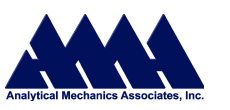Under the direction of Michael Mendenhall, NEAR has participated in a number of commercial projects to provide aerodynamic services for an advanced launch vehicle design and analysis program. The highlights of some recent projects are noted below.
- Orbital Sciences Corporation
NEAR effected the complete aerodynamic design and analysis for the standard Pegasus air-launched booster which flew successfully using only computational aerodynamic analyses; no wind tunnel tests were performed prior to the first flight. NEAR provided the aerodynamics and associated analyses for the Taurus ground launch vehicle. In addition, NEAR worked with Orbital on various tasks associated with the X-34 vehicle.
- The Kistler Aerospace K-1 reusable launch vehicle aerodynamics program
This effort included the entire range of aerodynamics techniques, from engineering aerodynamics to inviscid and viscous CFD to an extensive wind tunnel test program. NEAR had close interaction with many of the team members responsible for the various portions of the vehicle design and development.
Computational aerodynamics was used for the design and analysis of the Kistler K-1 reusable launch vehicle. The aerodynamic design methodology for this new vehicle is discussed, and analytical results are compared with wind tunnel test data where possible. The basic computational approach involved the use of all levels of prediction methods from engineering methods to CFD codes. The unique aerodynamic requirements for this innovative launch vehicle configuration dictated the computational methods which could be used, and it was necessary to rely heavily on applied CFD for the aerodynamic characteristics of the K-1 configuration components. The practical and economical uses of computational aerodynamic methods to provide results for a number of challenging and unusual fluid problems are described.  ICAS paper
ICAS paper
- Beal Aerospace BA-1 and BA-2 launch vehicles
NEAR provided aerodynamics data from analysis and wind tunnel tests for use by the various disciplines which required aerodynamic information for the design.
- NASA Marshall Space Flight Center
NEAR has an ongoing contract to further develop and provide support for an integrated aerodynamics design and analysis procedure for advanced launch vehicles. The objective is to provide the launch vehicle designer with an economical and practical means to analyze and evaluate new launch vehicles during the conceptual and preliminary design phases. State-of-the-art aerodynamics analysis methods, historical design guidelines, corporate memory and experience, and an experimental database are being incorporated into a knowledge-based system.  LVX software
LVX software
- Kelly Space & Technology, Inc.
NEAR provided aerodynamic analysis for use by Kelly in support of their NASA Space Transportation Architecture Study for the Marshall Space Flight Center in Huntsville, Alabama. Their concept was to develop a winged reusable booster that is tow-launched by a Boeing 747. The booster could loft either an expendable or reusable upper stage.
The aerodynamic analysis was for the entire mission profile which includes both ascent and descent. The flight regimes of concern encompass subsonic, supersonic, and hypersonic flow for mated (towed), unmated (released), and separated booster/upperstage configurations.
- Rocket Development Company
NEAR provided aerodynamic data for the Intrepid family of expendable launch vehicles (ELVs) from wind tunnel tests for use by the various disciplines which require aerodynamic information for the design.
In the above commercial launch vehicle programs, NEAR has been the team member representing aerodynamics. This involves working closely with GN&C, Structures, Performance, and Systems groups to provide the aerodynamics they need for their area. As part of this interaction process, NEAR understands the aerodynamic uncertainties and how they influence the use of the aerodynamic characteristics by the other disciplines.
NEAR understands the short schedules and fixed budgets which are typical of commercial programs. It is important to understand the kind of analyses appropriate for each specific problem; that is, what is good enough for the particular problem. It is not necessary to use the highest level CFD analysis for some problems in which a few hours estimate based on simple engineering methods is adequate. Because of our small size and flexibility, NEAR is available for quick turnaround of unique aerodynamics problems as they arise.
NEAR has experience in representing aerodynamics to outside reviewers. NEAR has an excellent reputation, and is viewed as an independent organization which presents unbiased aerodynamic results with credibility.
AERODYNAMICS and HYDRODYNAMICS
Aerodynamics Support Example
Missile Preliminary Design Studies
Missile Aerodynamic Loads Analysis
Launch Vehicle Aerodynamic Design and Analysis
Aircraft Store Separation and Carriage Loads Analysis
Unsteady Aircraft Aerodynamics
Maneuvering Submersible Hydrodynamic Analysis





